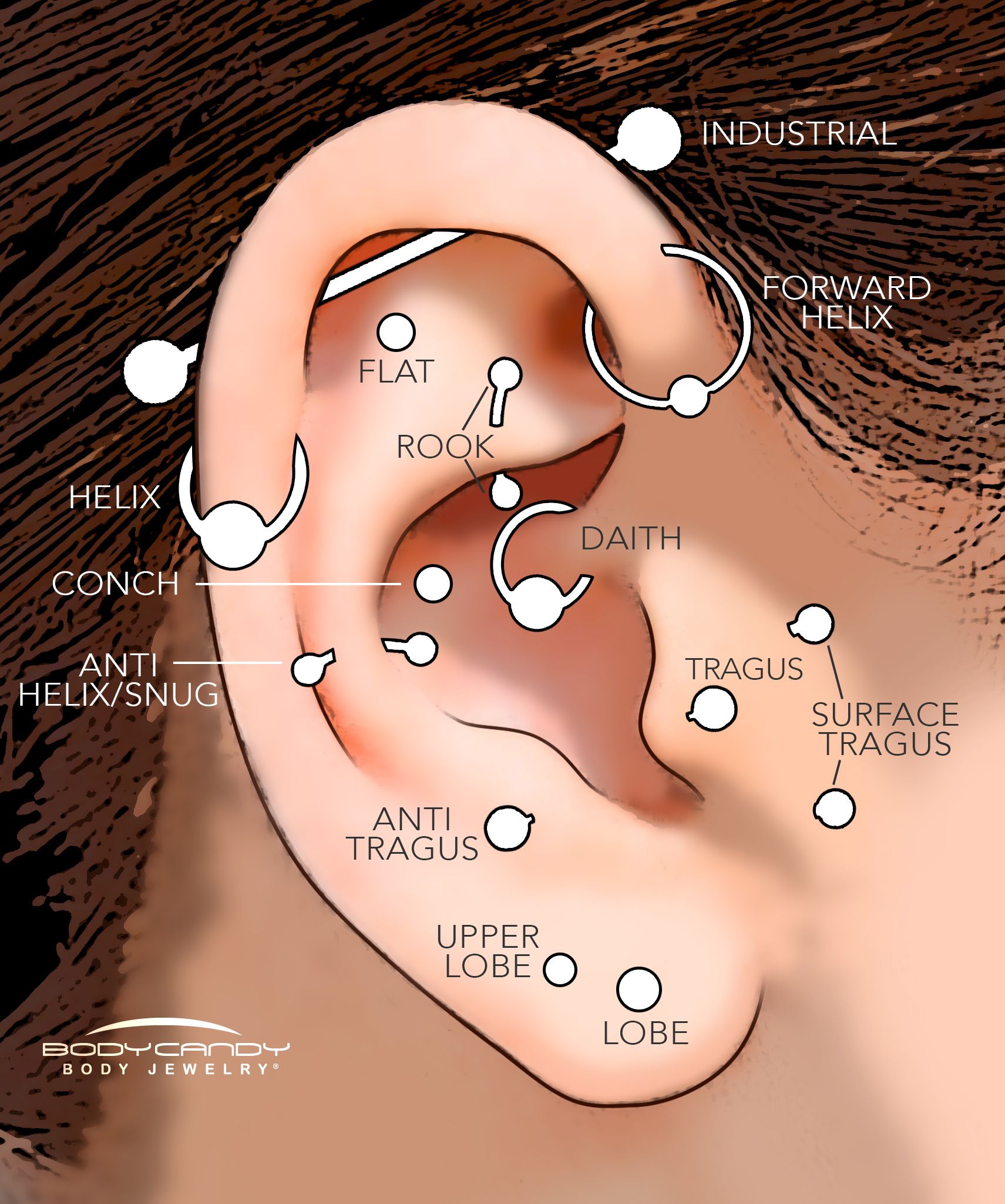Inspired by all the constellation, dermal, and septum piercings you’ve spotted on Instagram and considering booking an appointment to get one (or more) of your own? Before getting specific parts of your anatomy prodded, have a peruse through our definitive piercing guide for the 101 on what to expect—from how long it takes to heal to the best piercers you can go to in KL (once everything opens up, of course):
1. Think about what kind of piercing you want to get
There are a tonne of piercings to choose from so do your research! Consider what would best suit your anatomy, how it would impact your day-to-day life and whether the risks are worth it. Before you get overwhelmed, let us break the basics down for you properly.
Here are the different kinds of piercings you could get for each part of your body.
Ear

An ear piercing is the most convenient kind of piercing to get as it is easily concealable. In terms of pain, cartilaginous parts of your body are generally more painful to pierce than the fleshy parts, and they take longer to heal.
Before getting pierced, you should also consider which side you normally sleep on and which part of the ear you’re getting pierced—the initial pain inflicted while the piercing is healing will greatly affect how you go about your daily routine.
For instance, piercings like the helix, anti-helix, forward helix, and industrial are more painful to sleep on because lying on them puts a lot of direct pressure on the fresh wound. Other piercings that are placed further inside the ear like the conch, daith, and rook are less painful as they are more protected.
Further, piercings like the tragus and the daith look swell but they obstruct your ear canal, meaning that you will potentially be unable to use things like earphones or earplugs while they’re healing.
TIP: If your painful piercings are getting in the way of your shut-eye, try sleeping on a travel neck pillow with your ear in the hole!
Face

Facial piercings like the nose, septum, lip, or eyebrow are becoming trendier, seen lately on FKA Twigs, Zoë Kravitz and Miley Cyrus. These piercings are often more intimidating because they’re, well, on your face, which leaves most people either unconvinced about whether they would suit it or concerned about potential scarring.
In the former case, getting a septum piercing would give you the freedom to hide it when you don’t feel like having it on display. Alternatively, if a nostril, lip or eyebrow piercing is what you’re after, then remember that you can always take it out if you don’t like it—as long as it’s still “fresh”, it will heal over completely.
On the other hand, if you know what you want but you’re freaked out by the prospect of having a permanent scar, just remember that they are a simple reality of any body modification. If you decide to take the jewellery out eventually, rest assured that the remaining hole is usually small, pretty unnoticeable, and will shrink more with time.
Further, good piercers tend to plan piercing placement based on scarring. For example, nose piercing placements are usually in the fold of your nostril. This way, the hole is basically unnoticeable when there is no jewellery in it.
Body
View this post on Instagram
This includes anything from navel rings to nipple rings and dermal piercings. These are a little riskier as they are surface piercings, which means that they may migrate or reject.
Piercing migration is when the piercing moves (or, well, migrates) from its initial placement towards the surface of the skin, which is normal and often painless. Piercing rejection is when the piercing migrates out of the skin entirely, usually accompanied by redness, discomfort and a widening of the piercing hole.
If your piercing migrates, chances are that it will soon settle and heal beautifully. However, it’s difficult to tell the difference between migration and rejection in the early stages so if you’re concerned about the latter, just check with your piercer: If it is rejecting then you’ll probably be advised to just remove the jewellery immediately to minimise scarring.
2. Where you should get pierced
The cardinal rule of thumb when it comes to piercings is to MAKE SURE IT IS DONE SAFELY. It’s easy to forget that the process of getting a piercing is essentially surgical—you’re literally creating a puncture wound in your body. As a result, it’s important to consider a few things before you get too trigger happy.
Firstly, no piercing guns, please. This one seems like a no-brainer, but the legions of mall-side piercing parlours still operating prove us otherwise. The main attraction of the gun for many is that piercings that are done this way are cheaper and quicker, but we’re here to tell you that it is definitely not worth the risks.
Secondly, piercing guns cannot be adequately sterilised and the risk of infection transmission from one customer to the next is incredibly high. Not to mention, the gun pierces your skin by applying blunt force trauma. This is a huge no-no when it comes to cartilage piercings—the sheer force of the gun is enough to potentially shatter your cartilage (ouch!).
Finally, most piercers that use a gun do not have adequate training (learning by piercing teddy bears doesn’t count) and are therefore not likely to give you the results that you want. Instead, opt for a needle piercing which is more sterile, gentle and gives the piercer full control over the piercing placement.
Before getting your piercing, you should keep an eye out for a couple of things. Is the studio clean? Do they have an autoclave to adequately sterilise their equipment? Are their needles single use? If the answer to any of the above questions is a resounding “no”, please leave the premises ASAP.
Ahead, find some of our favourite piercing studios in KL.
READ: BURO Style dare: The fashion team get constellation piercings
Spec Body Art
View this post on Instagram
Address: Lot S130, 2nd Floor Sungei Wang Plaza, 50250 Kuala Lumpur
Call: 012 629 2090
Opening Hours: 1pm – 9pm, Tuesday – Sunday
Zoo Body Art
View this post on Instagram
Address: Lot F139 1st Floor, Sungei Wang Plaza, 55100 Kuala Lumpur
Call: 012 205 2566
Opening Hours: 12pm – 9pm daily
3. It’s going to hurt… but it’s over quick!
We’re not gonna lie to you—you’re sticking a needle through your body. It’s not going to be painless. That being said, it’s not completely unbearable. The amount of pain that you experience is dependent on a few factors such as:
- Which body part you’re piercing
- Your pain tolerance
- The skill of your piercer
Regardless, take a deep breath in, a deep breath out, and it’ll be over in a flash!
4. What jewellery to get
It can be tempting to settle for cheaper jewellery, but we urge you to shell out a little extra for better quality—it’ll be worth it in the long run. Cheap jewellery tends to contain higher traces of nickel which is a known allergen that causes contact dermatitis. This can lead to infections (something you definitely do not want in a fresh or healed piercing). Instead, hypoallergenic options like surgical steel and titanium are far more suitable.
Surgical steel is the most affordable material for piercing jewellery. However, if you want more colour options, titanium is a more expensive but more versatile alternative as it can be anodised (coloured) to suit your preferences, be it purple, yellow, green, or blue.
When buying jewellery, you’re also going to have to think about how big your piercing hole is (you can find out from your piercer). Generally, your ears and face tend to be pierced with 18G (1.0mm thickness) or 16G needles (1.2mm thickness), while your navel would typically be pierced with a 14G needle (1.6mm thickness).
When it comes to surface piercings, using jewellery of a bigger size can reduce the risk of rejection. Regardless, knowing the size of the needle you’re being pierced with will help you buy jewellery that fits your piercing. This is particularly important as—no surprise here—if you buy jewellery that is too thick, you won’t be able to fit it into the piercing hole.
Conversely, with nose rings, most tend to size down (i.e. go from 16G to 18G or 18G to 20G) so that they can use more delicate jewellery. Just keep in mind that if you size down in jewellery, it’s going to be a (literal) pain to size back up.
5. Aftercare
View this post on Instagram
What to expect from a new piercing
The advice given for aftercare varies depending on who you get pierced with, so you should just follow the advice of your piercer. Generally speaking, cleaning twice daily with sterile saline solution or gently cleaning the piercing in the shower with a mild soap are the recommended aftercare methods.
One thing that is to be expected is bleeding and crust formation—this is normal so fret not! The dried crusty bits that form on your piercing are just dried blood plasma and white blood cells (not pus) and is necessary for the healing of the piercing.
Bleeding should also stop within a few hours but may arise if the piercing is irritated. The key here is to never pick at the piercing—instead, simply soak the wound in saline or run warm water over it in the shower.
What to do with an infected piercing
A cause for concern is if there is inflammation at the piercing site accompanied by green or brownish pus, in which case you should see either your piercer or your doctor right away.
What to do if you encounter the dreaded piercing bump
You may encounter the dreaded hypertrophic scar or ‘piercing bump’ next to your new jewels. This is simply a buildup of scar tissue when the body works too hard to repair itself. Sometimes confused for keloids, hypertrophic scars are a separate entity because they do not spread further than the site of the piercing.
If you’ve got a bump, fret not—there are options. There are a lot of reasons why they appear, but the most common is excessive friction and irritation. For example, if you’re prone to fiddling with your piercing lots then kicking the habit will help it go away. Hoops and rings also contribute to piercing bumps because of how much they move around, so changing your jewellery may help your situation. Just remember—only do this if the piercing is healed or you’ll have more dire straits on your plate!
Another thing you could try to get rid of your bumpy friend is an aspirin paste mask—crush up an aspirin pill and mix with a few drops of water to form a paste then apply it on the bump. Supposedly, aspirin is anti-inflammatory which reduces swelling (Writer’s note: I’ve given this one a go, and I have to say it did get rid of the bump on my nose. However, that is no guarantee that the remedy will work for you, or that it works at all. That said, it’s worth a shot!). PS: This is not recommended for those who are pregnant or with allergies.
Find more stories like this here.
| SHARE THE STORY | |
| Explore More |




